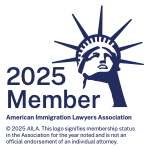RECENT ARTICLES
LEGAL SERVICES
By: Jennifer Fabian-Verzosa, Esq.
WHILE AN F-1 VISA IS INITIALLY INTENDED FOR TEMPORARY STUDY, SEVERAL PATHWAYS CAN EVENTUALLY LEAD TO U.S. PERMANENT RESIDENCY. THIS GUIDE EXPLORES OPTIONS AND KEY CONSIDERATIONS FOR F-1 STUDENTS SEEKING A GREEN CARD.

Studying in the United States on an F-1 visa is an incredible opportunity for academic growth and cultural immersion. For many international students, the experience sparks a desire to build a life and career in the U.S. long-term. If you are an F-1 student dreaming of one day obtaining Lawful Permanent Resident (LPR) status in the United States, commonly known as getting a “Green Card,” you are not alone.
What are the options for an F-1 Visa Student to Obtain a Green Card in the United States?
Understanding F-1 Visas and Immigrant Intent
The F-1 visa is a non-immigrant visa. This means that when you apply for and enter the US on an F-1, you must demonstrate "non-immigrant intent" – the intention to return to your home country after completing your studies. You typically need to show ties to your home country, such as a residence you do not intend to abandon.
Applying for a green card, however, signals immigrant intent – the desire to live in the US permanently. This might seem contradictory, but US immigration law also recognizes that a person's intentions can also change after they have lawfully entered the United States.
Pathways to a Green Card
Several avenues can lead from an F-1 visa to a green card:
1. Family-Based Green Card:
- Marriage to a U.S. Citizen or Lawful Permanent Resident: This is a common route for students who find love in the U.S.! Your U.S. Citizen or LPR spouse files Form I-130 Petition for Alien Relative.
- If married to a U.S. Citizen: You can usually file Form I-130 and Form I-485 Adjustment of Status application concurrently.
- You may be interested in: "Steps in Marriage-Based Adjustment of Status".
- Click here for "What to Expect at Your Adjustment of Status Interview".
- If married to an LPR: You file Form I-130 first and must wait for a visa number to become available (Important: Check the Visa Bulletin) before filing Form I-485. This wait can sometimes take years, requiring you to maintain status or potentially another valid status, or depart the US.
- Other Family: Sponsorship through U.S. Citizen parents (if you are under 21), U.S. citizen (if you are over 21), or U.S. Citizen siblings is possible but less direct for students actively on F-1 visas. Consulting with an immigration attorney is a wise idea to confirm your eligibility and the necessary steps involved.
2. Employment-Based (EB) Green Card:
Your education and potential work experience (such as through OPT/CPT) can also make you eligible for various employment-based categories:
- EB-1: Priority Workers: For individuals with extraordinary ability (sciences, arts, education, business, athletics), outstanding professors/researchers, or certain multinational managers/executives. EB-1A (Extraordinary Ability) allows for self-petitioning (no employer sponsor needed), but the standard is very high.
- EB-2: Advanced Degree or Exceptional Ability: For roles requiring an advanced degree (Master's or higher) or a Bachelor's plus five years of progressive experience, or for individuals with exceptional ability. Often requires employer sponsorship and a PERM labor certification (proving no qualified US workers are available).
- National Interest Waiver (NIW): A significant exception within EB-2 allows individuals (especially those in STEM fields or whose work holds substantial merit and national importance) to self-petition, bypassing the need for a specific job offer and PERM labor certification.
- EB-3: Skilled Workers, Professionals, Other Workers: For jobs requiring at least two years of training/experience (Skilled Workers), a Bachelor's degree (Professionals), or less than two years' experience (Other Workers). This category typically requires employer sponsorship and PERM labor certification.
- OPT/CPT Roles: Optional Practical Training (OPT) and Curricular Practical Training (CPT) allow you to gain valuable US work experience. This experience can lead to a job offer from an employer willing to sponsor you for an H-1B visa, EB-2 or EB-3 green card.
The Process: Adjustment of Status vs. Consular Processing
Once you have an approved immigrant petition (such as an I-130 or I-140) and an immigrant visa number is available for your category, you can apply for the green card itself:
- Adjustment of Status: If you are already inside the United States in valid status, you can typically apply for your green card by filing Form I-485 with USCIS. However, you must meet all other adjustment of status requirements!
- Consular Processing: If you are outside the United States or ineligible for adjustment of status, you can apply for an immigrant visa through a U.S. embassy or consulate in your home country after your immigrant petition is approved and a visa number is available. You must be admissible and meet the requirements for an immigrant visa, so it is a good idea to check with an immigration attorney to help confirm whether you might meet the requirements!
Crucial Tips for F-1 Students Interested in Applying for a Green Card in the Future
#1 TIP IS TO MAINTAIN YOUR F-1 STATUS! This cannot be stressed enough. Diligently maintain your F-1 status.
- Attend a full course load each required term.
- Work only as authorized: Be fully aware of on-campus limits, and obtain prior CPT/OPT authorization for off-campus work.
- Report address changes to your Designated School Official (DSO) immediately.
Even after filing an adjustment of status application, there are benefits to continuing to maintain your F-1 status. Mere filing of the application does not automatically terminate your F-1 status.

Even after filing your adjustment of status application, there are benefits to continuing to maintain your F-1 status.
Obtain Expert Help to Protect Your Future Dreams
U.S. immigration law is complex and constantly evolving, and the current immigration climate has been increasing hostile and unforgiving to F-1 students with status violations. Given the high stakes involved in pursuing permanent residency, it is recommended that you consult with an immigration attorney. An attorney can help assess your specific situation, explain the best options, guide you through the process, and help you avoid potential pitfalls to protect your future.
Transitioning from an F-1 student to a lawful permanent resident is achievable, but requires careful planning, understanding the legal requirements, and meticulous adherence to immigration rules. Whether through employment or family ties, exploring your options early and carefully maintaining your F-1 status are key steps on the path toward your goal of making the United States your permanent home.
Our IMMIGRATION LAW OFFICE is experienced with helping international students navigate the green card application process. Our client-centered law office will be here for you every step of the way, from filing to interview preparation. We provide both in-person and remote immigration legal services to students in educational programs all over the United States. Contact us today!
________________
*For Article Requests, Republications, or Speaking Engagements, please email: jennifer@law-jf.com







